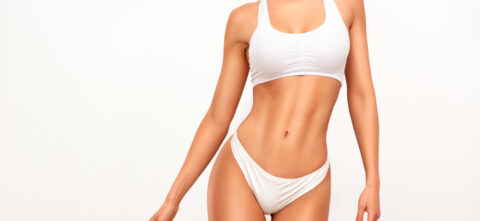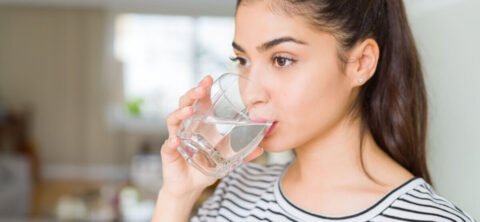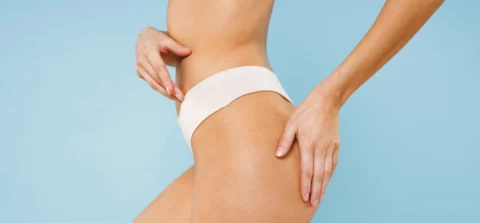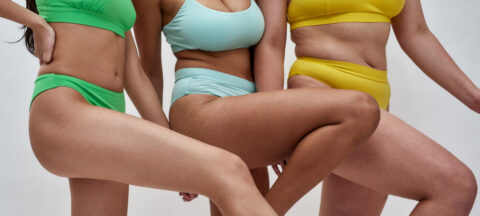CoolSculpting is safe, easy, and noninvasive, but that doesn’t mean that patients don’t walk away with side effects and symptoms after the treatment. While some patients do report experiencing little to no symptoms such as swelling and bruising, others deal with these lingering discomforts for days or weeks afterwards.
So what are the best ways to reduce swelling and decrease your recovery time after a CoolSculpting procedure? Here are our 5 tips:
- Prepare and learn everything you need to know
- Drink tons of water and eat healthy
- Wear compression clothing
- Get a massage
- Stay active
We go more into each point below, as well as everything else you need to know after CoolSculpting.
CoolSculpting: Your Treatment is Done – Now What?
While CoolSculpting is a noninvasive procedure, meaning individuals can mostly expect to return to their daily routines immediately following the treatment, there are some temporary symptoms and effects that any patient might possibly experience afterwards.
The most important thing to remember is that your body will look worse before it looks better. Although it is noninvasive, the body might negatively react to the treatment for a temporary time. In the worst cases, bruising, swelling, and pain can last for several weeks, making some patients think that their treatment has failed or gone wrong.
Every person reacts uniquely to the CoolSculpting procedure, with symptoms varying depending factors such as the treated area, the expertise of the doctor and the type of applicator used, the person’s individual pain tolerance, and more.
Some individuals may experience little to no symptoms, while others might experience symptoms that can persist for several weeks following the treatment. Either way, symptoms of CoolSculpting are almost always mild symptoms that cause minor or no discomfort; they also always subside over a certain amount of time and no patients report long-lasting complications due to symptoms.
Here are some of the symptoms you might experience:
- Tenderness, swelling, and bruising directly around the treated area. These symptoms can last a few days or 1-2 weeks
- Stinging, cramping, tingling, nerve pain around the treated area, particularly if treated on the stomach or abdomen. This will only last for up to a day in most cases
- Feelings of nausea in the abdomen
- Itching or dulling of sensation on the treated area
- Numbness on the treated area that persists for 1-3 weeks
It is normal to look and feel swollen and bloated on the treated area following a treatment, which is why compression clothing is a popular garment of choice for CoolSculpting patients.
Many individuals also report an increase of symptom sensation 4-10 days after the treatment, and become worried when they believe that the symptoms are worsening instead of going away. These symptoms are generally mild to moderate, but feel worse during night time when the patient is trying to sleep.
If you experience this, there is no need to worry; these symptoms are caused by your body’s natural inflammatory response to the presence of dead fat cells. When the body properly removes the dead fat cells, your last symptoms should start to fade away. If you have trouble with sleep, prescription sleeping aid may be prescribed to you.
The Road to Recovery: 5 Tips on Reducing Swelling and Increasing Healing Following Your CoolSculpting Treatment

No one likes downtime, and even with the noninvasive nature of CoolSculpting, swelling and recovery time can still be quite a burden. But there are ways you can improve your body’s natural healing time, reduce your overall recovery time, and get back to normal as fast as possible.
Here are our 5 tips on how to maximize your recovery:
1) Prepare and Learn Everything You Need To Know
Now we know what you might say – “But it’s CoolSculpting! There’s no preparation involved!” While that’s mostly true, if you want to make sure to maximize your recovery and get the most out of your downtime, it’s important that you know everything that’s going to happen. “Winging” your experience and learning what you need to know step-by-step can lead to less efficient recovery and preparation.
Here are a few things you need to make sure you cover before your treatment:
Ask about your number of treatments: Your overall recovery time might depend on the number of treatments you want to have. Talk to your doctor and discuss with them the number of procedures that might work best for you.
While some individuals only have a single treatment, others repeat their treatments every few months. This depends on the amount of fat reduction you would like, as well as any other areas you might want to have treated.
Document your experience: Before you step in for your CoolSculpting treatment, you might want to document your entire experience. While some might want to share their experience with their friends or online, we understand that others might prefer to keep it to themselves.
Even just documenting the experience for your own benefit can potentially help you with your next treatments – seeing pictures of yourself at certain stages, documenting recovery times and symptoms, figuring out what you can do to make your personal recovery better than last time.
Prepare for possible pain: A small number of patients, about 1 out of every 10, report experiencing moderate pain during the treatment, as well as pain that lasts a few days or a few weeks around the treated area. If you believe that you have below average pain tolerance levels, then you might want to talk to your CoolSculpting doctor about possible medication that you can take during your recovery.
Some doctors will recommend 600mg – 800mg of ibuprofen three times a day during recovery, for as long as the patient experiences moderate or greater pain in the treated area. In some cases, you might need a prescription medication, although this is a very rare necessity.
Prepare your downtime: CoolSculpting won’t stop you from engaging in your normal routines following the treatment; you can continue what you normally do as soon as you leave the office. However, if you want to care for yourself in the best way possible, then it might help to take it easy for the next week following the treatment. Prepare for your downtime and try to minimize any physically-demanding activities (although light exercise is still recommended).
If you fear that you might experience more swelling or pain than the average CoolSculpting patient, then you should definitely see what you can do to avoid intense activities for up to a week after your treatment.
2) Drink Tons of Water and Eat Healthy

You probably already know that the ideal patient for CoolSculpting treatments is at or near their ideal body weight. This means that most if not all CoolSculpting patients already practice a healthy lifestyle – water, healthy food, and proper exercise, and they have already experienced weight loss and are looking for fat reduction.
You want to keep yourself fully hydrated following every CoolSculpting session, for two main reasons:
- Water naturally keeps you healthy and improves your vital systems
- More specifically, recovery involves flushing the frozen and dead fat cells out of your body, and the more water in your system, the more effectively and quickly you can flush those fat cells out.
Try to avoid alcohol and sugary drinks for a week following your treatment; stick to water exclusively until you feel like your old self again.
As for your diet, you want to continue eating the kind of diet that helped you attain your ideal or near ideal body weight in the first place. This means avoiding foods that are high in sugar content and starch, as well as processed and fried food. Try to eat only whole grains, protein, vegetables, and fruits in the first week following your treatment. While it might be tempting to sneak in a pizza post-treatment to help yourself feel better, it’s not what your body needs during recovery (just save it for next week!).
3) Wear Compression Clothing
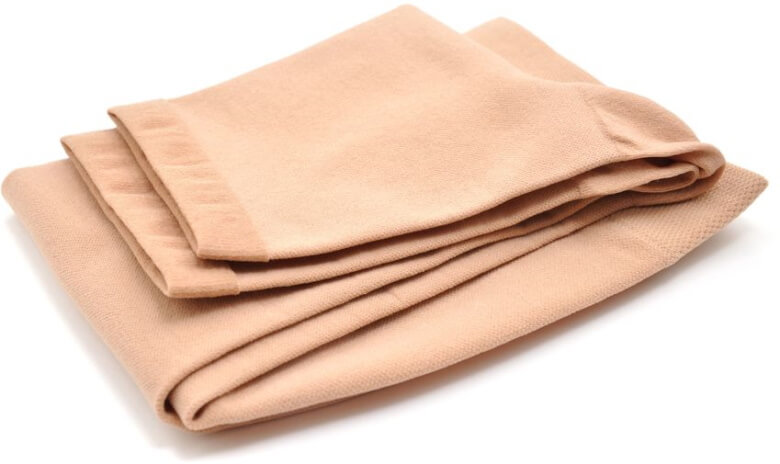
One tip that many doctors recommend is wearing compression-style clothing such as Spanx after the procedure. While a compression garment won’t necessarily create better overall results, some individuals have reported feeling better more quickly while wearing compression garments for a few weeks following a treatment.
So how exactly does compression clothing help with recovery? Compression clothing is the kind of skintight clothing that many women wear at the gym as fitness clothing; super tight garments that wrap around the skin. Aside from being skintight and outlining the wearer’s body shape, there does some to be some science behind the design of compression clothing.
Compression clothing is said to shorten recovery time and improve performance in both high-performance athletes and average gym-goers, due to its tight hold around the skin. This tightness increases lymphatic flow and blood flow to the limbs, giving the body more power in those areas.
While compression clothing was first popularized by female triathletes and runners, the last few years has seen a spike in popularity in compression clothing amongst all kinds of athletes, both men and women. Other benefits of compression clothing include reducing the pooling of sweat around certain areas and keeping the body warm, without restricting movement of the joints.
Popular pieces of compression clothing include socks, shorts, upper body tops, and of course, Spanx. Wearing these after a cool sculpting session is guaranteed to help with your recovery. And remember: listen to your body. Wear them for as long as you still feel uncomfortable and swollen. If you don’t want to go out wearing compression clothing, you can always wear them secretly under your regular clothes!
4) Get a Massage

Any good CoolSculpting provider will vigorously massage the treated area after the CoolSculpting applicator has been removed – a 2-5-minute uncomfortable, deep tissue massage that really targets the dead fat cells under the skin – but you will need more massages than that if you want to maximize results and minimize recovery time.
Your provider might teach you how to give yourself these massages a few times a day for 5-10 minutes each, directly on and surrounding the treated area. For maximum effect from your massage, you will want to get lymphatic massages on the treated area.
A lymphatic massage, or lymphatic draining massage, is a type of massage that maximizes the body’s waste and toxin removal systems, allowing your body to more effectively remove the frozen dead fat cells from your system. To perform a lymphatic massage, you will want to keep in mind the following tips:
- Be gentle – the massage should only affect the skin, not the muscles underneath
- Keep the massaging hands relaxed
- If swollen, be extra gentle with the massage
- Help flush the body by drinking 2-4 glasses of water after every lymphatic massage
To perform this massage, you will want to massage mostly with your palms and your fingers. Move in slow, repetitive, circular motions, and gently continue until the area feels tight after a few minutes.
If you are performing the lymphatic massage properly (or having it performed on you properly), you will notice a significant reduction in your swelling over the next day or two, as well as less stiffness in the general area. You will fall in love with this type of massage in no time!
5) Stay Active

Our final tip: stay active. While you can take 1-2 days off from your regular exercise routine after the CoolSculpting experience to give your body a short break, we don’t recommend going on an extended hiatus from any kind of exercise.
Your body needs activity so that you can keep your blood flowing, allowing for quicker swelling reduction as well as more effective fat cell drainage. We’ve observed that most individuals who experience extended bouts of post-CoolSculpting symptoms are those who took extended breaks from even light exercise after their treatment.
So stay active! If you feel too bruised or sore to engage in your regular exercise routines, then try something else; stretching, jogging, and swimming are easy ways to keep your body moving without exerting too much effort.
Looking to Learn More About CoolSculpting? Contact Us at Ethos Spa Today
If you are interested in learning more about CoolSculpting or would like to schedule an appointment for a CoolSculpting consultation, contact us at Ethos Aesthetics + Wellness today!
As one of the premier providers of CoolSculpting and other skin and laser procedures in New Jersey, our team and staff at Ethos Spa has successfully treated countless men and women with CoolSculpting all over the body.
Let us know what you are looking for with CoolSculpting and we will help you achieve your dream body and aesthetic as soon as possible.
Read more:
Weight Gain After CoolSculpting: What Happens?
CoolSculpting on the Outer Thigh: Can I Get Rid of My Saddlebags?


